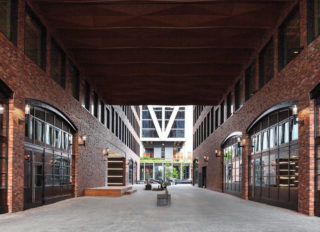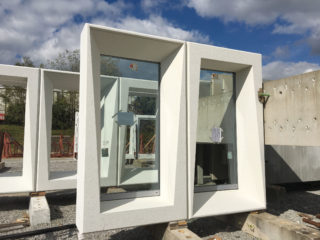< Read more from “Building Materials, Ancient to Future”
Two-and-a-half-trillion square feet. That’s the equivalent of 50 New York cities, and it’s the amount of new construction the world can expect to see in the next 40 years, if current trends continue. Meanwhile, the climate is in crisis, with the need to reduce emissions more urgent each day.
Buildings are responsible for nearly 40% of total greenhouse gas emissions, which makes the challenge to architects clear: find ways to use less energy—or else.
And that includes embodied energy.
What is embodied energy?
Simply put, it’s the energy expended to make a building. It’s normally expressed in megajoules.
How is embodied energy computed?
Take the windows in a new office building. You’d need to add up the energy expended to extract the raw materials, make the glass, shape it, coat it, crate the finished windows, ship them to the site, lift them into position, and so on. You could also add the energy needed to maintain the glass and, eventually, to remove and recycle it. A calculation that includes those final steps is called a life-cycle assessment (LCA). Doing that for all the materials in a building comprises a whole building life-cycle assessment (WBLCA).
How is embodied carbon different from embodied energy?
Energy is “cleaner” in some places than in others. For example, power in the Pacific Northwest is generally produced hydroelectrically, while power in China tends to be produced by burning coal. So, while it takes the same amount of energy to make rebar in either location, rebar from China can have up to six times the embodied carbon as rebar from, say, the Nucor steel mill in Seattle.
Six times as much?
Yes. So where a building product comes from really matters.
And that means embodied carbon is a better measure than embodied energy?
Yes. It reflects what really matters, environmentally: the amount of carbon being released into the atmosphere. It’s normally be expressed as tons of CO2e—that is, of CO2 and its equivalents.
Shouldn’t architects focus on making buildings more efficient to light and cool?
Reducing the amount of energy it takes to operate a finished building is important. But the energy embodied in a building can be as much as 50% of the energy used to operate a building in its first 50 years. And as the amount of energy needed to operate buildings decreases, thanks to improvements in materials and systems, the relative importance of embodied energy will only increase.
To put it even more starkly, according to the UN Environment – Global Status Report 2018, nearly one-third of building-related emissions, or 11% of total emissions, come from embodied, as opposed to operational, energy.
I’ve heard it’s also important to look at the “time value of carbon.” What does that mean?
When thinking about the impact greenhouse gases have on the environment, what matters is not just how much carbon a process releases, but when that carbon is released. (Carbon released today will be in the air longer, and thus will do more damage to the environment, than carbon emitted 20 years from now.) Once a building has been constructed, the embodied carbon has already been emitted, whereas carbon from operations will be released over time.
As stated by Anthony Pak, an LCA consultant based in Vancouver, Canada, “If we don’t reduce emissions now and end up triggering some tipping points as a result, it may not matter how energy-efficient our buildings are 60 years from now.”
What’s the best way to decrease the embodied energy in a building?
Try to reuse an existing building. If you can’t do that, try to build less. Half the building means half the embodied energy—nothing complicated about that calculation.
What if I can’t build less?
Then choose materials with the lowest embodied carbon among the available options.
There are so many options. Where do I begin?
Start where you can do the most good. “Structural systems almost always comprise the largest source of embodied carbon in the building—up to 80%, depending on the building type,” says Paula Melton, editorial director of BuildingGreen. If the structure is concrete, try using a low-cement variety. (By some estimates, production of Portland cement is responsible for 5% of total global CO2 emissions.) If the structure is steel, try to use as little as possible. (Diagonally braced frames, for example, tend to use far less steel than moment frames.) And use recycled steel—better yet, steel recycled using clean energy—whenever possible.
Is wood always a good choice, in terms of embodied energy, since trees store carbon?
Scientists are all over the place on this. That’s why Kate Simonen, an embodied carbon expert at the University of Washington, advises architects to choose the material that’s best for a given project, then use it judiciously. “If you take the average concrete building and compare it to the average wood building, you might see that many different studies show wood tends to have a lower carbon footprint,” she notes. “That doesn’t say you couldn’t have optimized the concrete system to
be at a similar level.”
Is there an easy way to compare different options?
Two online tools dominate the U.S. market—Athena Impact Estimator and Tally. Another program worth checking out is One Click LCA. And a free-to-use, open-source embodied carbon calculator, EC3, will be released at the Greenbuild conference in Atlanta in November.
Doesn’t LEED already handle this?
Hardly. Under LEED v4.1, you can get up to five points for performing a WBLCA. But you can also get points for doing things that will increase the embodied carbon in a building.
How can that be?
The two energy goals—cutting embodied energy and cutting operational energy—can be at odds. To choose the simplest example: The better insulated your building is, the less energy it will take to heat and cool. But it takes energy to make insulation, transport it, and install it. So, in that case, decreasing the operational energy—which can get you LEED points—requires increasing the embodied energy.
Is there a certification system that is better on the question of embodied carbon?
The Living Building Challenge is a certification system that “sets the bar where it needs to be,” says Eric Corey Freed, an architect, author, and advocate based in Portland, Oregon.
What is the government doing about embodied energy?
Good question. In June, U.S. Senator Amy Klobuchar introduced a bill to “require transparency in reporting the greenhouse gas impacts of products procured by certain federal agencies.” That’s a start. California already has a law, being phased in over the next two years, that will help the state procure building materials that meet certain global warming potential targets. Other states are looking at similar “buy clean” legislation.
What about city governments?
There are scattered efforts. Vancouver, as part of its Climate Emergency Response, has called for a 40% reduction in the embodied carbon of new buildings and infrastructure from a 2018 baseline.
And in New York?
The private sector is taking the lead. For example, Amanda Kaminsky, founder of Building Product Ecosystems, a consulting firm, is working with developers and two city agencies to replace up to 40% of the Portland cement in new concrete with regionally-recycled glass. According to Kaminsky, the change lowers the concrete’s embodied carbon because manufacturing cement produces much more CO2 than is produced cleaning and grinding the necessary quantity of glass.
What is the AIA doing?
National AIA has several initiatives, including “developing a framework to track embodied carbon” in response to a 2018 letter from 50 architecture and engineering firms, according to spokesman Matt Tinder. AIA New York, through its Committee on the Environment, will sponsor a panel discussion on the ways material choices, layout, and structural efficiency can reduce embodied carbon (January 16 at the Center for Architecture).
How do we persuade clients to care about embodied energy?
Talk dollars and cents. The best way to reduce embodied energy is to use less stuff. And less stuff costs less money. You can also tell your commercial or institutional clients that, right now, focusing on embodied carbon is a way to differentiate themselves from their competitors, by demonstrating leadership on this important issue.
With thanks to Donald Davies of Magnusson Klemencic Associates, Stacey Smedley of Skanska, Martin Torres of Walter P Moore, Frances Yang of Arup, and the experts quoted above.













